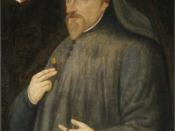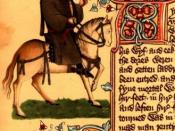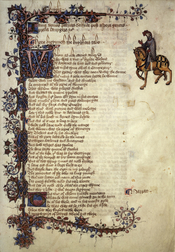In the fourteenth century, utilizing description, narration, and details, Geoffrey Chaucer depicts an array of characters in his renowned piece, "Canterbury Tales". Chaucer's stories have survived the test of time and today are considered masterpieces. During the fourteenth centuries noble men exercising their literacy, read many stories. Yet, many women during the fourteenth century lacked literacy and therefore heard many stories from wandering players and troubadours who added entertainment to their monotonous and dreary, lives. Chaucer reads and hears many of these stories and writes them down. Chaucer demonstrated excellence by connecting the stories with the tellers. These tellers, in their attitudes and mannerisms, represent people who would know and tell the specific story. Two such characters are the Knight who represents courtly love and the Miller who represents the reality of love.
Chaucer, in his "Prologue of the Canterbury Tales", describes the Knight as, "Truly a perfect gentle knight," (Chaucer, 98).
He, "followed chivalry, truth, honor, generosity, and courtesy," (Chaucer, 98). The Knight never makes rude and uncouth comments, for he "never yet a boorish thing had said," (Chaucer, 98). The Knight in his complete perfection tells a tale of courtly love, which contains all the details, and sanguinity of a perfect match, ideal love, and the ultimate respect towards lovers. Contrasting the Knight's ideal perspective upon love follows the Miller with his physical emphasis.
The Miller, "a great stout fellow big in brawn and bone," (Chaucer, 107), tells a tale of physical love. Moreover, "The Miller's Tale" shows the reality of love. The Miller's grotesque mannerisms qualify him as "a wrangler and a buffoon," (Chaucer 107). Chaucer creates a character with boisterous traits embedded in his personality. These traits allowed Chaucer to create an unruly man commonly associated with drinking. The Miller enlightens his fellow travelers with a,


